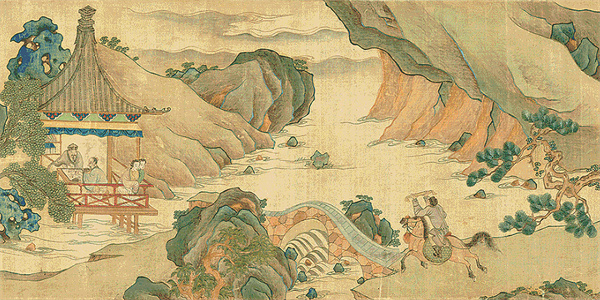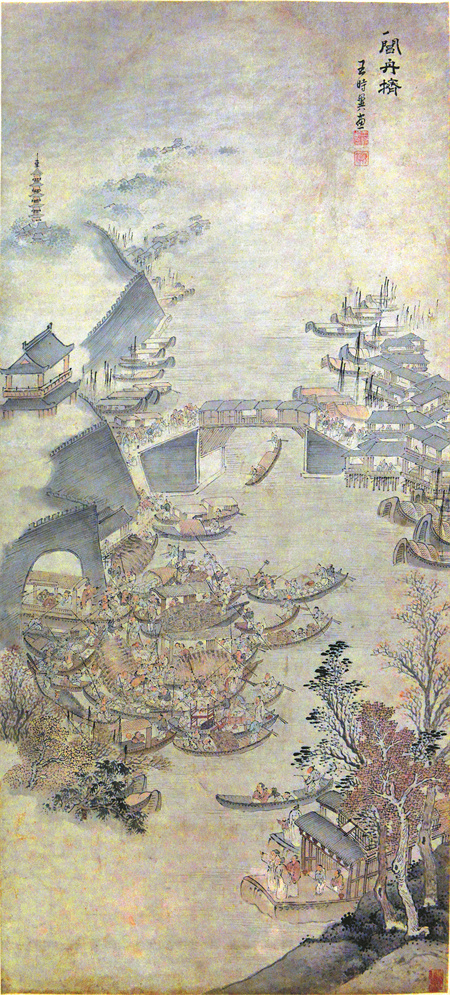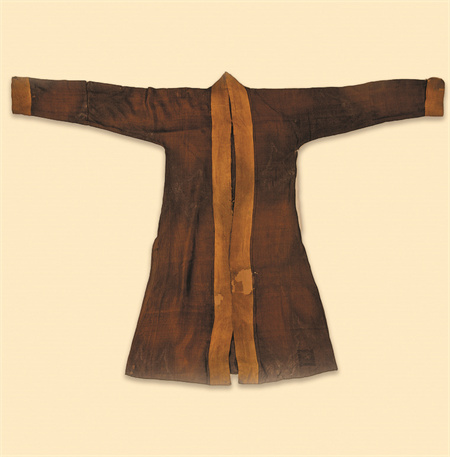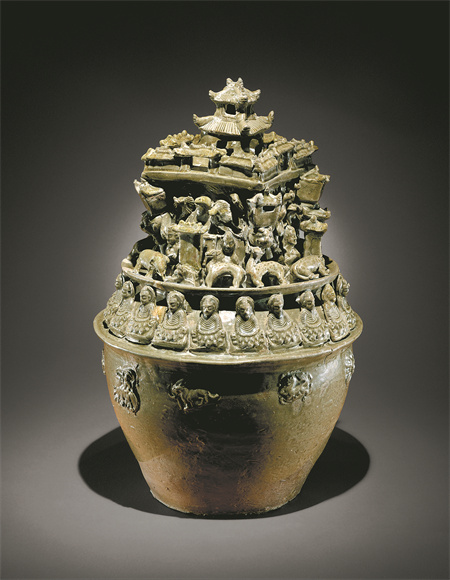The jewel in China's crown

The embroidery, titled Mount East, captures the moment when news of victory was delivered to Xie An, a fourth-century statesman. It was commissioned by Ming Dynasty (1368-1644) artist Dong Qichang for a friend.[Photo provided to China Daily]
Editor's note: From a place of exile to a cultural and economic powerhouse, the influence of Jiangnan still echoes in China today. The next three pages will take you on a journey through this verdant land's eternal poetry, art and spirit.
Two benign-looking gentlemen are playing chess under the roof of a little stilted pavilion, which itself is embedded in a picturesque landscape complete with verdant mountains and meandering streams. At one with their game, the men, occupying the left side of an embroidered canvas, stand in contrast with their two female companions who are leaning against the railing, apparently having found something more worthy of their attention.
From the other side of the picture, a courier has galloped into view on a stallion, the flailing tail and flared nostrils of which suggest a frantic ride. The man is holding, with both of his raised hands, what appears to be a scroll.
It indeed is a scroll, a written one containing a message of such importance to the Eastern Jin Dynasty (317-420) that it is comparable to the one delivered by the legendary courier Pheidippides to his fellow Athenians who were waiting for news from the Battle of Marathon.
The soldiers of Eastern Jin had just routed their enemies from the north, who outnumbered them by almost twofold. The battle, which took place in the winter of 383, secured in Chinese history the place of one man — Xie An, upon whose strategy the front-line commanders of the Eastern Jin army had acted and to whom the news of victory was delivered, in a classic moment when a seemingly unflappable Xie clashed with a friend on a chessboard.
It also helped to prevent any pillaging that could have happened to the adopted seat of power of the Eastern Jin, founded by a key member of the ruling family of the Western Jin Dynasty (265-316) who crossed the Yangtze River from the north with his supporters in 317.
"The relocation of the Jin court, from central China to the southern region known as Jiangnan, was propelled by the harassment and invasions of the steppe empires from the north," says Clarissa von Spee, curator of the exhibition China's Southern Paradise: Treasures from the Lower Yangzi Delta, on view at the Cleveland Museum of Art in the US city of Cleveland, Ohio.
Jiangnan, which literally translates into "land south of the (Yangtze) river", sits on the southern part of that delta. With more than 240 exhibits drawn from museums worldwide, the grand display intends to explain the land's remarkable transformation — from a fringe area where unenlightened locals wore "truncated hair and heavy tattooing" to quote from an ancient piece of literature, to a fertile ground that served as a cultural and economic powerhouse.

This Qing Dynasty (1644-1911) hanging scroll by Wang Shiyi captures the busy morning traffic at the Chang Gate of the Jiangnan city of Suzhou during the 17th century.[Photo provided to China Daily]
"None of that would have happened without a drastic change of demographics," says Von Spee, referring to the influx of immigrants into Jiangnan around 317, some of whom were also driven from their home by the repeated flooding of the Yellow River, which ran across the Chinese heartland.
Between the Western and Eastern Jin dynasties, a pattern was set for Chinese history as much as for Jiangnan: In the ensuing 17 centuries, whenever the north was engulfed in war or political instability, people moved southward, to Jiangnan, the haven and last defensive foothold upon which the fate of an empire would often hinge.
Xie (320-385) was born three years after that fateful relocation first made a Jiangnan city the capital, and therefore political center, of a Chinese empire. Keeping in mind that the literarily minded man had been living a rather reclusive existence before being called upon by history, Xie effectively became an object of veneration for successive generations of educated Chinese, who considered his self-imposed solitude as not only a show of dignity, but also a prelude to great personal success.
The aforementioned piece, a painting-cum-embroidery with certain areas — the horse's saddle and the pine needles for example — highlighted with stitches, was commissioned by the powerful Ming Dynasty art theorist Dong Qichang (1555-1636). Dong intended it as a gift for a fellow official who was taking an extended leave from office, beseeching the recipient to "end your hiatus for the sake of the masses", to quote from Dong's own postscript to the work, written in 1632.
One thing is worth noting: During Dong's life, Jiangnan already constituted China's biggest talent pool, with natives, including Dong, occupying key positions in the central government of the Ming empire (1368-1644). Between Xie and Dong, Jiangnan had seen its own prestige rising steadily, to the point that it became the place to look to for the best China had to offer.

A silk gauze robe from the Southern Song Dynasty (1127-1279).[Photo provided to China Daily]
"When the great northern families immigrated to Jiangnan around 317, they took with them their much-valued traditions of painting and calligraphy, of poetry and Buddhism," says Shi Yuan, a researcher from the Shanghai Museum, which owns the partially embroidered piece.
Xie, a patriarch of a prominent family, was a close associate of Wang Xizhi, the single most enshrined calligrapher in Chinese history, whose own uncle, Wang Dao, was a driving force behind the relocation of the Jin court.
When Wang Xizhi gathered his eminent friends for a drinking and poetry writing party in the spring of 353, Xie was invited. The event, taking place amid the beautiful Jiangnan scenery, was immortalized through Wang Xizhi's writing, before being re-imagined in countless paintings for later generations, creating a strong visual bond between the land and the proponents of the country's elite culture.
A capital location
China descended into a state of chaos upon the demise of Eastern Jin in 420, and stayed fragmented until the founding of the Sui Dynasty in 581. The Sui emperors — there were only two of them — oversaw the digging of the Grand Canal, the world's longest artificial waterway which was to run between the modern-day Beijing and Jiangnan city of Hangzhou, Zhejiang province.
"The aim was to facilitate the transportation of men and materials — Jiangnan's rice produce for example — between the south and the north," says Von Spee. More than a millennium later, the same canal would carry the rulers of Qing (1644-1911), China's last feudal dynasty, to Jiangnan, to project their power over the empire's "source of tax and talents" to quote the legendary Qing emperor Kangxi.

A funerary urn, from around the third to fourth century, with green glaze and decoration.[Photo provided to China Daily]
In other words, although a distinct regional awareness had emerged in Jiangnan as early as the 4th century, the area was by no means a haven unto itself. Through close interaction with the rest of China, it became a reference point and a source of inspiration, putting its cultural stamp on many things we now consider quintessentially Chinese.
One example involves the poetry production of the Tang Dynasty (618-907). This powerful empire, whose territory at one point stretched between the Korean Peninsula in the east to present-day Afghanistan in the west, was politically centered in modern-day Shaanxi province in northwestern China. Yet its poets, who outshone those from all other historical periods in China, frequently traveled to Jiangnan, where they were duly impressed by the otherworldly beauty of its misty landscape and wrote tirelessly about it. One of them, named Wei Zhuang, reflected that "this place, where one sleeps to the sound of rain, is for a weathered traveler to age".
When violent rebellion broke out in 755 and shook the Tang empire to its core, people, among them men of words, fled for Jiangnan, where they nurtured their grief while listening to the endless rain, only to return to the north years later to pour out their memories on paper.
However, the defining moment for Jiangnan didn't come until 1127, toward the very end of China's Northern Song Dynasty (960-1127). That year, the Song emperor Zhao Ji and his son Zhao Huan, who by that point had succeeded his father, were captured by their arch-nemeses — the Jurchen armies from the north who rode into the Song capital of Bianjing (modern-day Kaifeng in Henan province) on horseback and ransacked the city.
What the Song court did in the face of imminent demise held up a mirror to history: They moved their capital across the Yangtze River, to Lin'an (modern-day Hangzhou), the southernmost end of the Grand Canal.
"The comparability is obvious, but there were also major differences. While the Jin rulers were pushed into Jiangnan by circumstance, their Song counterparts clearly felt its pull. Knowing too well the potential of Jiangnan, the latter helped to fully unlock it in the ensuing one-and-a-half centuries," says Zhao Feng, dean of Zhejiang University's School of Art and Archaeology.
Following the relocation of the Song court, China's silk and textile production center shifted from the country's north to Jiangnan, whose warm climate made it ideal for both the growing of mulberry trees and the wearing of flimsy silk clothing. The Cleveland show features a 12th-century silk gauze robe on loan from the Hangzhou-based China National Silk Museum — one of 80 articles of silk clothing unearthed from the tomb of an upper-class lady in the region.
And silk, like the locally produced green porcelain known as celadon, became Jiangnan's biggest export to international and domestic markets. Immense wealth was generated where the ruling elite resided, giving rise to a dynamic luxury sector catering to their demands.
"Jade, mahogany wood, rhinoceros horn — none of them were indigenous to Jiangnan, yet they were all sent to the workshops there to be sweated over by the country's best craftsmen, before being sold on the local market," says Shi.
Brushes with greatness
When it came to taste, Jiangnan had the final word. This was even truer in the sphere of high culture. Landscape painting, the tradition of which started in China in around the 7th century, found its ultimate expression in the vistas of Jiangnan's water-rich scenery, which it in turn helped to eternalize.
"Landscape became a primary subject matter, and the works collectively went through a transition from the stark, vertical compositions of the Northern Song to a horizontal format to which the watery environment readily lent itself," says Von Spee.
As towering mountains gave way to rambling waters, numerous hand-scrolls — as opposed to hanging scrolls — were painted, making the viewing experience similar to the one a person would have ambling along a river bank. One of them, on view in Cleveland, was painted by Mi Youren, son of calligrapher Mi Fu, in 1130. It was a thank-you gift for a friend, who had provided the younger Mi with shelter after his arrival in Jiangnan following the relocation of the Song court.
Both father and son were celebrated by the Southern Song emperors, who not only championed, but also practiced, art — most notably painting and calligraphy — with a fervor not to be repeated in Chinese history. The cultural and economic strengths Jiangnan gained during this time were to stay with her, although the region, after Southern Song, almost never served as the political center of a Chinese empire — except for the initial few decades of the Ming Dynasty.
Densely cultivated fields routinely appear in Ming-period landscapes, testifying to an embrace of realism that also led the painters to capture the merchant ships "gathering like clouds" around the mouth of the Chang Gate, an intersection of three major streets and a canal in the modern-day city of Suzhou which, before the rise of Shanghai in the late 19th century, was Jiangnan's — and China's — biggest commercial center.
In 1689, the Chang Gate had a special visitor — Emperor Kangxi of the Qing Dynasty (1644-1911), whose Manchu ancestors defeated the Ming troops and who, clearly recognizing Jiangnan as the jewel in the crown, traveled to the region six times during his 61-year-long reign.
This particular tour, second of the six, was re-created by court artists in a series of laboriously painted hand-scrolls, including one on view at the current exhibition. On loan from the University of Alberta Museums, the scroll, measuring 22.2 meters long, illustrates, in a central scene, Kangxi's arrival by boat at the gate.
The streets are decorated, lined with residents standing or kneeling as the imperial fleet approaches. There is no sign of the vehement opposition the emperor's ancestors once faced in Jiangnan, where they, by virtue of being the ethnic minority Manchu people, were viewed with great hostility and even greater suspicion.
This was before the Qing rulers — Kangxi and his equally long-reigning grandson Qianlong being two salient examples — proved themselves great patrons capable of "bringing Jiangnan to its heights", to use Von Spee's words.
By commissioning large quantities of goods — carved jade and porcelain, for instance — from Jiangnan artists and artisans, the Qing rulers promoted the region, which contributed one-third of the empire's tax revenue, while subtly imposing their own cultural standards.
Calling Jiangnan "an advantaged area with abundant water resources", Von Spee also credits the decision-making of those responsible for Jiangnan's fate for the region's enduring prosperity.
"We all know that the Southern Song emperors had an appeasement policy — they would rather pay silk than go to war with their enemies in the north. Consequently, there's this general perception of them being weak," she says. "But if you think about it, Confucianism is much more about wise politics than forcing things through military power.
"They could have gone down in history as fierce warriors, but that could have been a totally different story for Jiangnan."
A few centuries earlier, toward the end of one of those periods of division in Chinese history, the ruler of Wuyue, a 10th-century kingdom that controlled the land of Jiangnan, chose to surrender peacefully to the founding emperor of the Song Dynasty, who united China, once again.
But that doesn't mean that Jiangnan was always spared.
"The (Jiangnan) city of Yangzhou was badly shaken upon its capture by the Manchu troops during the Ming-Qing transition. And the whole Jiangnan area was leveled during the Taiping Rebellion in the second half of the 19th century," says Von Spee. "Each time, it bounced back."
Deciding that "every human being responds to beauty", the curator has served up plenty of it to fill six galleries, without forgetting to hint — ever-subtly — at its price.
Visually overwhelming, a piece of green stoneware on loan from New York's Metropolitan Museum of Art is topped with a multistoried palatial structure held aloft by a flock of birds and surrounded by auspicious animals including an elephant and a deer. Accompanying this Taoist vision of the paradise are a row of Buddhas seated on the vessel's shoulder, signifying the merging of two beliefs in Jiangnan between the late 300s and early 400s, a time when the Chinese empire splintered into north and south, with the latter occupied by Eastern Jin.
The vessel, labeled funerary urn, is known in Chinese as hunping, or "bottle for the souls".
"Some scholars believe that they are the souls of people who lost their lives on the flight to the south of the river, the area we now call Jiangnan," says Von Spee.
Related articles
-
 The Fight over the Two Peaches Killing Three Warriors
The Fight over the Two Peaches Killing Three WarriorsMore
-
 Stories and scenes of the world bloom under a writer's painting brushes
Stories and scenes of the world bloom under a writer's painting brushesMore
-
 Oil artist's infusion of East and West inspires Beijing salon
Oil artist's infusion of East and West inspires Beijing salonMore
-
 Museum celebrates artist's work
Museum celebrates artist's workMore
-
 UCCA announces the first presentation of Maria Lassnig’s work in China
UCCA announces the first presentation of Maria Lassnig’s work in ChinaMore
-
 Artist with a bird's eye view
Artist with a bird's eye viewMore
